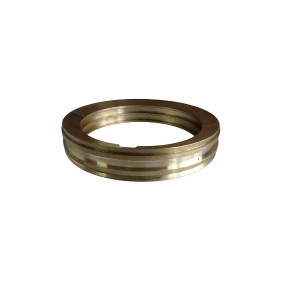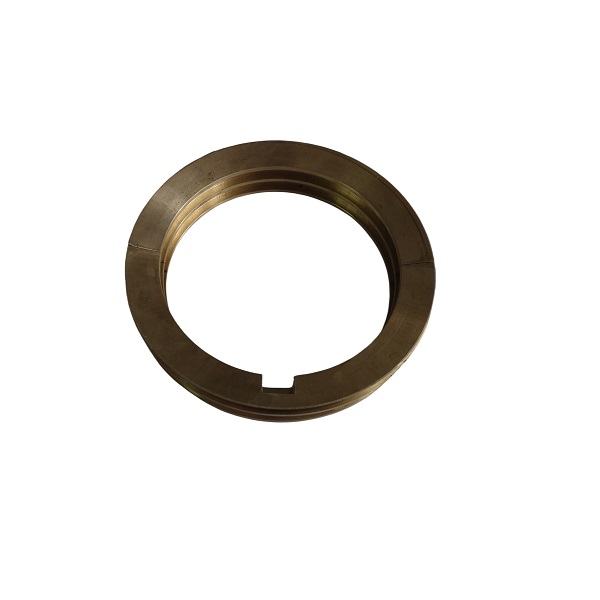In the operation of power plant boiler feedwater pumps, the HZB200-430-01-09 oil slinger in the thrust bearing is a crucial component for ensuring safe and stable equipment operation. Inspection of the oil slinger during overhauls is a critical step in ensuring the long-term, reliable operation of the feedwater pump. As a core component of the thrust bearing system, the condition of the oil slinger directly affects the bearing’s lubrication effectiveness and service life. Today, we will detail the key points to focus on when inspecting the oil slinger during overhauls, providing practical guidance for power plant operators and maintenance personnel.
I. Structure and Function of the Oil Slinger
The HZB200-430-01-09 oil slinger ring is a key component installed in the thrust bearing. Its primary function is to evenly distribute lubricating oil into the bearing, forming an effective lubricating film. The oil slinger is typically made of a wear-resistant and high-temperature resistant alloy. It is annular in shape with angled oil guide grooves on its outer edge. During feedwater pump operation, the oil slinger rotates with the shaft, scooping up lubricating oil from the oil sump and evenly distributing it to all parts of the bearing.

When inspecting the oil slinger during an overhaul, first verify its structural integrity. Observe the slinger for cracks, gaps, or deformation, as these defects can directly affect its oil slinging effectiveness. Also, check the slinger’s oil guide groove for integrity and for wear or blockage, which can affect even oil distribution.
II. Key Points for Inspection of Oil Slinger Wear and Deformation
The oil slinger HZB200-430-01-09 will wear and deform over time due to friction and fluctuating oil temperatures. During an overhaul, inspecting the slinger’s wear is crucial. Use a vernier caliper to measure the thickness of the slinger and compare it to a new part to confirm the extent of wear. Pay particular attention to the wear on the outer edge of the slinger and the oil guide groove, as these areas experience the most wear.
Inspecting the slinger for deformation is also crucial. Place the slinger on a flat surface and inspect its flatness. Significant warping or deformation will affect its fit with the bearing, resulting in reduced oil slinging effectiveness. At the same time, check the roundness of the oil slinger to ensure it maintains a stable oil-shedding effect during rotation.
III. Oil Slinger Installation Position and Clearance Inspection
The installation position and clearance of the oil slinger HZB200-430-01-09 are crucial to bearing lubrication. During overhaul, the correct installation position of the oil slinger must be checked. Confirm that the oil slinger is installed in the designated position on the thrust bearing and that there is no offset or tilt. Improper installation will prevent the oil slinger from effectively slinging lubricant, affecting bearing lubrication.
Also, check the clearance between the oil slinger and the bearing end face. The size of this clearance directly affects the oil-shedding effect. Excessive clearance prevents the lubricant from being effectively shed to the bearing, while too small a clearance may cause friction between the oil slinger and the bearing end face, resulting in additional wear. Use a feeler gauge to measure the clearance between the oil slinger and the bearing end face to ensure it is within the designed range.
Also, check the clearance between the oil slinger and the thrust plate. Too small a clearance may cause the oil slinger to contact the thrust plate, affecting oil-shedding effect; too large a clearance may prevent the oil slinger from effectively slinging lubricant. Confirm by measurement whether the clearance is within the acceptable range.
IV. Oil Flinger Ring Material and Corrosion Assessment
The material of the oil slinger HZB200-430-01-09 directly impacts its service life and reliability. During an overhaul, assess whether the oil slinger’s material meets design requirements. Specifically, check for corrosion, pitting, or oxidation on the surface of the oil slinger. Corrosion is particularly prevalent in oil slingers operating in high-temperature, high-humidity environments.
Inspect the oil slinger ring surface for oil stains or carbon deposits. These deposits can affect the slinger’s rotation and oil shedding performance. If significant carbon deposits are found, clean with an appropriate cleaning agent to minimize impact on oil shedding performance.
Also, inspect the slinger ring surface for scratches or wear. These marks may be caused by foreign matter or improper installation. Severe scratches can affect the slinger’s rotational stability and reduce oil shedding performance.
V. Common Problems and Solutions During Oil Flinger Ring Inspections
Common problems identified during inspections of the HZB200-430-01-09 oil slinger ring include excessive wear, deformation, corrosion, and improper installation. Excessively worn oil slingers should be replaced; minor deformation can be corrected; severely corroded oil slingers must be replaced.

When addressing oil slinger ring issues, ensure the use of materials and specifications consistent with the original design. Avoid using incompatible replacement parts, as this can affect system performance. Also, maintain records during the inspection process to provide a reference for subsequent maintenance.
In summary, oil slinger ring HZB200-430-01-09 inspection should not be overlooked during maintenance of power plant boiler feedwater pumps. While small, oil slingers play a significant role. Only by incorporating oil slinger ring inspection into routine maintenance can safe and stable operation of power plant boiler feedwater pumps be truly achieved. During overhauls, a comprehensive inspection of the oil slinger ring is a critical step in ensuring long-term, reliable operation of the equipment and should not be overlooked.
When looking for high-quality, reliable boiler feedwater pump parts, YOYIK is undoubtedly a choice worth considering. The company specializes in providing a variety of power equipment including steam turbine accessories, and has won wide acclaim for its high-quality products and services. For more information or inquiries, please contact the customer service below:
E-mail: sales@yoyik.com
Tel: +86-838-2226655
Whatsapp: +86-13618105229
Yoyik offers various types of power plants spare parts for steam turbines, generators, boilers as below:
Test Solenoid Valve 22Fda-F5T-W110R-20/Lv
Block Valve Sd61H-P55170V
Stop Valve J65Y-2500Spl 15Crmo
Hydrogen Side Ac Oil Pump Hsnh280-43Z
Pump Mechanical Seal Hsnh440
Stop Valve Pj61Y-320
Electric Gate Valve Z961Y-1500Lb
Stop Valve J41H-100
Diaphragm For Bladder Accumulators Nxq2-L63/31.5
Pump P.Sl63/45A
Electric Stop Valve J961Y-320I
Stop Valve J41J-16C
Electric Stop Valve J965Y-200
Electric Stop Valve J961Y-P55.519V
Pressure Relief Valve Ysf9-138/130Kkj
Pompa Piston Jacking Oil Turbine A.A10Vso100 Dr/31R-Ppa12Noo
Vacuum Stop Valve Dkj61Y-100V
Check Valve H40H-40
Stop Valve J21Y-P555200P
Stop Valve J61Y-P5410V
Oil Pump Gpa2-16-E-30-R
Valve Solenoid 3Wmr6A50B
Electric Butterfly Valve D943H-16C
Electric Stop Valve J961Y-160
Stop Valve J61H-600Lb
Bladder Nxq F 6.3 / 20
Double Hydraulic Gear Pump Cb-B200
Medium Pressure Shut-Off Valve Wj20F3.2P
Stop Valve J65Y-630I
Instrument Valve Pn25 Dn4
Electric Stop Valve J965Y-64I
Stop Valve J11H-16C
Oil Seal Fy100-65X2700
Stop Valve J21H-16P
Post time: Sep-10-2025













